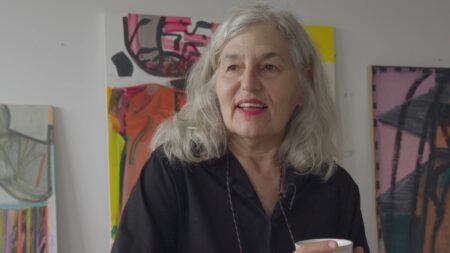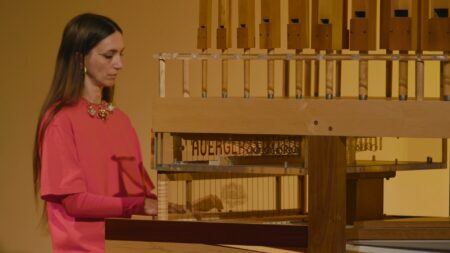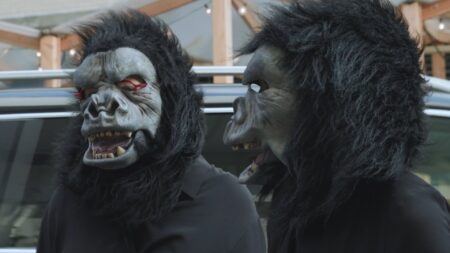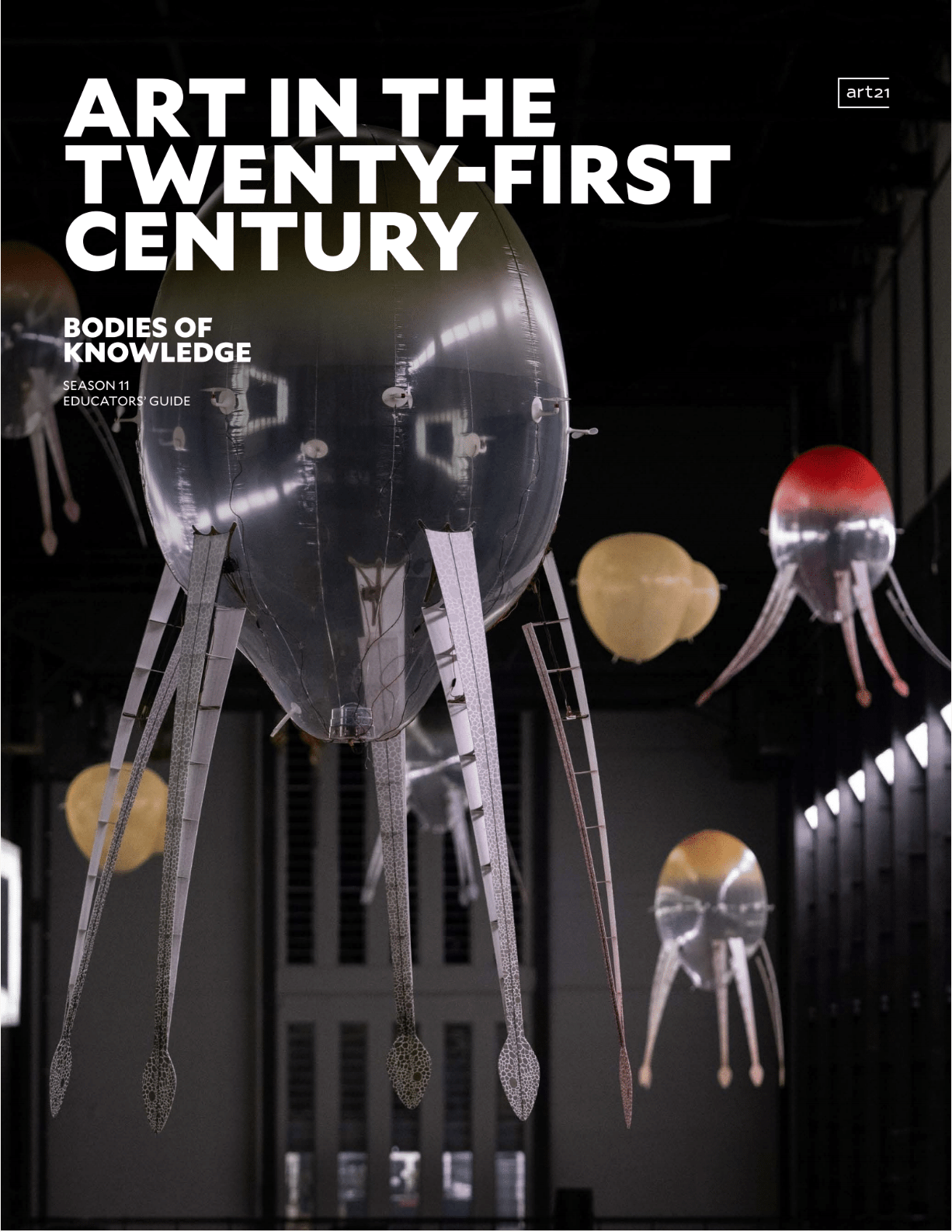Continue playing
(Time remaining: )
Play from beginning
Continue playing "{{ controller.videos[controller.getVideo(controller.currentVideo)].segmentParentTitle}}"
{{controller.videos[controller.getVideo(controller.currentVideo)].title}} has ended.
Hank Willis Thomas in "Bodies of Knowledge"
Descriptive audio version available here.
Visit our Awards page for this film’s honors and recognition.
As a child, artist Hank Willis Thomas was told he stared too much and asked too many questions. Today, these very attributes shape his artistic practice, which pivots on the theme of perspective. “All of my work is about framing and contexts,” says the artist. “Depending on where you’re standing, it really shapes your perspective of the truth, of reality, and of what’s important.” Reading Roland Barthes’ Camera Lucida, Thomas was struck by the idea of the punctum, the part of an image that impacts and stays with the viewer. Drawing from his background in photography to augment his work with other media, the artist’s sculptural works like Liberty (2015) isolate this punctum and translate it into three-dimensional space.
In his research, Thomas encountered the 1967 photobook by Ernest Cole documenting South African Apartheid. In particular, the artist was struck by an image of 13 coal miners being stripped nude for a medical examination. Rather than reproduce their exploitation and objectification, Thomas denies the viewer their naked bodies in his sculpture Raise Up (2014), instead isolating the miners’ heads and raised arms, confronting viewers with their gaze. Shortly after Thomas created Raise Up, the phrase “Hands up, Don’t shoot” became a popular protest chant in the wake of the police murder of Michael Brown in Ferguson, MI. As he mines history through photography, Thomas draws connections between past and present to illustrate the continuing logics of oppression that shape Black life.
At Walla Walla Foundry in Washington, molten bronze is poured into specially designed casts to create the 609 individual pieces that will be welded together to form The Embrace (2023), a public memorial to Rev. Dr. Martin Luther King Jr. and Coretta Scott King to be installed in the Boston Common. The sculpture depicts two sets of arms intertwined in a loving embrace, referencing a photograph of the Kings embracing after Martin won the Nobel Prize in 1964. Envisioning his work as being as much about each of us as it is about the Kings, Thomas creates space for the public to engage with the sculpture physically and ensures it is accessible to as many people as possible. “I’d like to believe this is just the beginning of a new way of thinking about how public space can be viewed, and how we reflect on the past with care and concern for the future,” says Thomas.
More information and creditsCredits
Executive Producer: Tina Kukielski. Series Producer: Nick Ravich. Director: Malika Zouhali-Worrall. Producer: Danielle Varga. Editor: Steven J. Golliday. Director of Photography: Naiti Gámez. Assistant Curator: Jurrell Lewis. Associate Producer: Andrea Chung. Design & Animation: Ryan Carl, Nikita Iziev. Composer: Andrew Orkin.
Additional Photography: Julia Liu, Jenni Morello, Mattia Ramberti, Brianna Wray. Assistant Camera: George Alvarez, Javier Castillo, Allen Dobbins, Sarah Jaffe, Todd Leatherman. Location Sound: Jim Choi, La’Ron Cooper, Damon Karys, Alberto Ladduca, Lily van Leeuwen, Taylor Roy, Emily Strong, Tommaso Zerbini. Field Producer: Ursula Liang. Production Coordinators: Sasha Leitmann, Arjun Pothuri. Production Assistants: Connor Finn, Kabir Kumar-Hardy, Quan Robinson, Gordon Taylor, Mishel Valle-Ayala. Art Handlers: Robert Guynn, Chris Rogy.
Advising Proder: Ian Forster. Video Post-Production Services: Cut + Measure. Video Post-Production Producer: Alex Laviola. Colorist: Chris Ramey. Online & Conform: David Gauff. Additional Video Editor: Addison Post. Post-Production Coordinator: Leah Ford. Additional Animation: Andy Cahill, Yasmin Mistry. Audio Post-Production Sound Services: Konsonant Post. Re-Recording Mixers: Gisela Fullà-Silvestre, Ben Kruse. Sound Editor: Ben Kruse. Assistant Editors: Ellen Askey, Stephanie Cen, Michelle Hanks. Station Relations De Shields Associates. Legal Counsel: Withersworldwide. Additional Curatorial Research: Susan Thompson.
Additional Art21 Staff: Lauren Barnett, Hannah DeGarmo, Lolita Fierro, Joe Fusaro, Molaundo Jones, Emma Nordin, Anna Pruett, Jessica Svenson, Noor Tamari, Nora Wimmer. Interns: Stephanie Ades, Sekou Cherif, Yeon Cho, Michaela Esteban, Emma Flood, Amber He, Carina Martinez, Renee Rienecker, James Santiago, Adam Varca, Dani Wieder.
Artwork Courtesy: Tauba Auerbach, Guerrilla Girls, Hank Willis Thomas, Anicka Yi, Paula Cooper Gallery, Jack Shainman Gallery, Gladstone Gallery, Anicka Yi, “Metaspore” at Pirelli HangarBicocca, Milan, 2022.
Archival Materials: Kelvin Adjei-Akosah, Agence France-Presse, Associated Press
Bettmann, Lance Brewer, David Briddell, Ron Cogswell, David M. Rubenstein Rare Book & Manuscript Library, Duke University; Embrace Boston, Equal Justice Initiative , Estate of Ernest Cole, Getty Images, Great Voices of Bulgaria, The Guardian, Amy Harrison, Human Pictures, Hulton Archive, Library of Congress, Magnum Photos, MASS Design Group, The New Press, Steven Probert, Public Art Fund, SandenWolff, San Francisco Museum of Modern Art, Jon Santos, Katja Schulz, Davina Semo, Ted Shaffrey, Skyhorse Publishing, Clarissa Sligh, Damon Styer, Tate Modern, Temple University Press, Time Inc, TV1 Broadcast Company, Bulgaria; Richard Vogel, W. W. Norton & Company.
Interviewees: Cleo Berliner, Esther Chao, Jonathan Evans, Coco Fusco, Sam Giarratani, Jasmine Guzman, Rujeko Hockley, Emily Majors, Muna Malik, Cameron Mesirow, Roberto Morales, Frances Morris, Sriranjini Raman, Samhita Ramji, Juan Rojero, Will Sylvester, Jawaid Toppa, Dr. Deborah Willis.
Special Thanks: The Art21 Board of Trustees, Xabier Arakistain, John Felix Arnold, Art Gallery of Ontario, Joseph Becker, Bert Bergen, Olivia Berke, Alessandro Bianchi, Sanford Biggers, The Boston Foundation, Alessandro Cane, Christina Caputo, Yu Rim Chung, Collection of the City of Boston, Allison Cooper, Christian Dioulo, Folasade Falebita, Jenny Gheith, Goodman Gallery, South Africa, Andy Greenberg, Remina Greenfield, Fiammetta Griccioli, Clara Hatcher Baruth, Imari Jeffries, Thomas Kelley, Rob Massey, Stacee Prigmore Monroe, National Memorial for Peace and Justice, A. Joaquin Navas, Negative Space, Devan Owens, Fernando Ramirez, Erik Savercool, Melissa Shakun, Hana Tran, Saulius Valaitis, Walla Walla Foundry, The Wave Organ, Maria Wiles, Family of Hank Willis Thomas.
Major underwriting for Season 11 of Art in the Twenty-First Century is provided by PBS, National Endowment for the Arts, Lambent Foundation, The Anna-Maria and Stephen Kellen Foundation, The Andy Warhol Foundation for the Visual Arts, The Horace W. Goldsmith Foundation, Toby Devan Lewis, Robert Lehman Foundation, and Nion McEvoy & Leslie Berriman.
Series Creators: Susan Dowling and Susan Sollins.
©2023 Art21, Inc.
Closed captionsAvailable in English, German, Romanian, Italian, Japanese, Korean, Chinese, Italian
Through the Art21 Translation Project, multilingual audiences from around the globe can contribute translations, making Art21 films more accessible worldwide. Translate this video now.
Interested in showing this film in an exhibition or public screening? To license this video please visit Licensing & Reproduction.
Hank Willis Thomas was born in 1976 in Plainfield, New Jersey, and currently lives and works in New York City. The artist received his BFA from New York University in 1998 and his MFA from California College of the Arts in 2004. Thomas’ work traces a line between the past and the present, using photography and sculpture to call viewers’ attention to how context shapes one’s understanding of the world around them. Appropriating recognizable photographs, gestures, and iconography while using a variety of strategies to move viewers with and around his works, the artist weaves together narratives that reframe the present by more fully examining our history.
“All of my work is about framing and context, and about how, depending on where you’re standing, it really shapes your perspective of the truth, of reality, and that’s what’s important.”
Hank Willis Thomas





